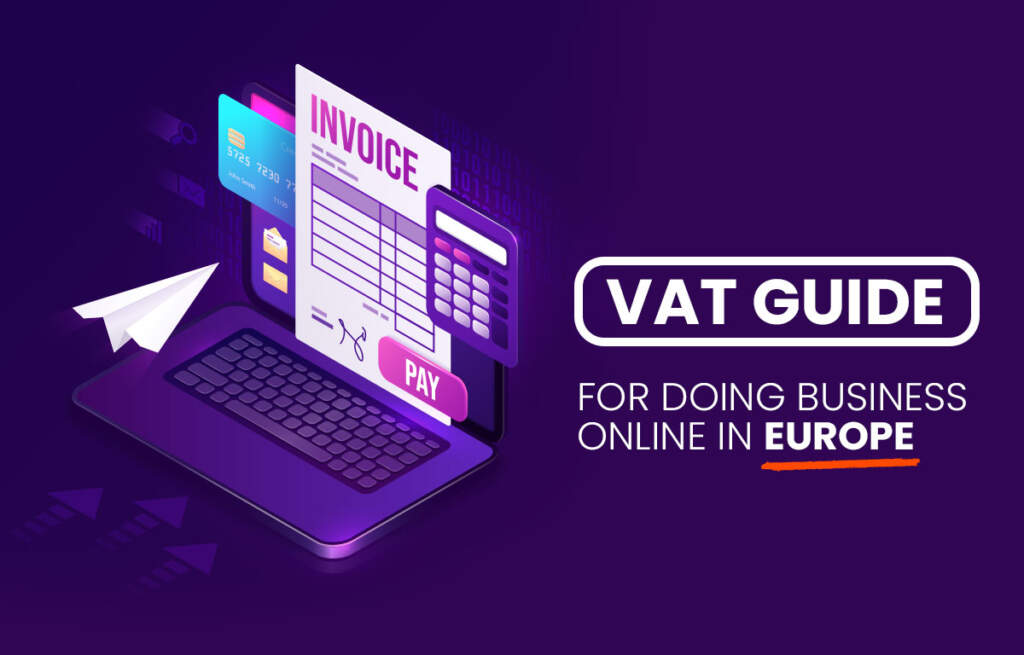Value-added Tax (VAT) is a general tax people pay to consume certain goods and services. When it comes to eCommerce or online businesses, you must be aware of several rules and principles around VAT as an online business owner.
- What is VAT?
- What are the VAT policies for EU and non-EU countries?
- Which VAT policy should I follow if my customer is in an EU country but I’m not?
In this article, we’ll give you a comprehensive understanding of VAT, the rules and regulations, challenges related to compliance, tips on managing VAT obligations, and more. Let’s jump right in.
Key Principles and Regulations Governing VAT in Europe
Although business owners register and pay VAT, it is an indirect tax. This is because VAT is charged by businesses to customers and buyers who consume their goods and services. Thus, VAT is paid from the amount collected from the customers. Furthermore, since business owners will also pay the VAT to other businesses, the taxation system remains neutral.
VAT is a percentage of the cost of the goods or the service. This percentage is called the VAT rate. Usually, businesses must pay VAT to the government authorities at the end of the year. However, the tax only applies if the business's revenue crosses a certain threshold. This is known as the turnover threshold. The VAT rates and turnover thresholds differ for countries within and outside the European Union. The exhaustive list of VAT rates and turnover thresholds for all European countries (EU and non-EU) is in the next section.
Countries also charge penalties and fines if a business is not VAT compliant. Failing to register, filing a return, paying the VAT, and having errors in the VAT declaration will cost you an additional penalty. These vary between countries and are flexible as the final verdict rests upon the country's government.
VAT Rates and Turnover Thresholds for European Countries
| Country | VAT Rate | Turnover Threshold |
| Austria | 20% | € 10,000 |
| Belgium | 21% | € 10,000 |
| Bulgaria | 20% | BGN ~19,570 |
| Cyprus | 19% | € 10,000 |
| Czechia | 21% | CZK ~276,300 |
| Germany | 19% | € 10,000 |
| Denmark | 25% | DKK ~74,400 |
| Estonia | 20% | € 10,000 |
| Greece | 24% | € 10,000 |
| Spain | 21% | € 10,000 |
| Finland | 24% | € 10,000 |
| France | 23% | € 10,000 |
| Croatia | 25% | HRK ~74,900 |
| Hungary | 27% | HUF ~3,512,000 |
| Ireland | 23% | € 10,000 |
| Italy | 22% | € 10,000 |
| Lithuania | 21% | € 10,000 |
| Luxembourg | 17% | € 10,000 |
| Latvia | 21% | € 10,000 |
| Malta | 18% | € 10,000 |
| Netherlands | 21% | € 10,000 |
| Poland | 23% | PLN ~45,800 |
| Portugal | 23% | € 10,000 |
| Romania | 19% | RON ~49,300 |
| Sweden | 25% | SEK ~102,000 |
| Slovenia | 22% | € 10,000 |
| Slovakia | 20% | € 10,000 |
| Russia | 20% | - |
| Ukraine | 20% | UAH 1,000,000 |
| Norway | 25% | NOK 50,000 |
| United Kingdom | 20% | £85,000 |
| Belarus | 20% | €10,000 |
| Kazakhstan | 12% | - |
| Iceland | 24% | ISK 2,000,000 |
| Serbia | 20% | RSD 8,000,000 |
| Bosnia and Herzegovina | 17% | BAM 50,000 |
| Switzerland | 7.7% | CHF 100,000 |
| Moldova | 20% | MDL 1,200,000 |
| Albania | 20% | ALL 10,000,000 |
| North Macedonia | 18% | MKD 2,000,000 |
| Turkey | 18% | - |
| Montenegro | 21% | €30,000 |
| Azerbaijan | 18% | AZN 200,000 |
| Georgia | 18% | GEL 100,000 |
| Andorra | 4.5% | €40,000 |
| Liechtenstein | 7.7% | CHF 100,000 |
| Monaco | 20% | €33,100 |
| Armenia | 20% | AMD 115,000,000 |
You're also able to look up the VAT rate per country using the following tools:
Exemptions, Deductions, and Special Provisions Within the VAT System
VAT has several special cases and exemptions under the system. These are as follows:
- The standard rate for EU countries shouldn’t be less than 15%. However, for non-EU countries, the standard rate differs and has been given in the table above.
- For certain services, the VAT can be reduced, considering the business follows the directives given by the authorities. The reduced rate cannot be less than 5%.
- Besides these, there are parking rates or intermediary rates for goods and services not listed in the directives list. These would allow businesses to pay a reduced VAT rate, which shouldn’t be less than 12%.
- Above and beyond this, you will be exempted from paying a VAT if you do not cross the threshold pertaining to your country.
Common Challenges and Issues Related to VAT Compliance
Although VAT streamlines the taxation process, it still comes with its own share of challenges.
- The rules for VAT on cross-border payments remain slightly vague for certain countries. This is because one would remain unclear on whose VAT rate they should be charging. Furthermore, if the transaction is between a non-EU business and an EU citizen or vice versa, the VAT rules will need clarity.
- While the government enforces several rules, regulations, checks, and audits to ensure that business owners pay the right amount of VAT, there are fraud issues. The government collects lesser VAT than it should, and as a result, more stringent policies must be enforced to prevent such fraudulent activities.
- Managing VAT and being on top of the relevant rules and procedures costs eCommerce businesses additional overhead costs. These include hiring and training the right talent, managing VAT, and paying fees to individuals who fulfill the complete legal process for businesses.
Tips and Recommendations to Effectively Manage VAT Obligations
To manage VAT effectively for online businesses, you need to follow the below steps:
Register Your Business
If you’re an EU-based company, registration would be relatively simple. You just need to register with the local tax authority. However, if you aren’t, and your business is based in a non-EU country, you must opt for VAT MOSS (Mini One-Stop Shop). This is only if you want to scale to EU countries.
Once you register, you’ll get a VAT number, and you can always access a government portal to file your VAT. For non-EU countries, the portal is called VAT MOSS. With this, you can pay all your VAT in one filing process. Thus, the portal streamlines the process largely for you, for most European countries.
Verify Your Customers
To verify your customers, you must first determine if the customer is a business or an individual. If it is a business, it will have its own VAT number, which you can use in the VIES portal to determine if the customer is actually running a business. If it is an individual, you need to get their details for shipping. While you do so, you can verify their country address by asking for one of the below details:
- The billing address
- Location of the customer’s bank
- Country where they got their credit card
- Buyer’s device’s IP address
- Country where they got their SIM card
If you need to verify the identity of your customer at the point of checkout on your eshop or website, here are some customer identity verification tools to help with that.
Determine the VAT Charge
You’ll need to consider the following factors to determine if you must charge your customers a VAT.
- Are you based in an EU or non-EU country?
- Is your customer based in an EU or non-EU country?
- Whether your goods are applicable for a VAT tax?
- What is the country’s VAT rate?
Answering these questions will help you know whether or not you should charge your customers. You'll then able to how to price your products and services profitably.
Save Your Invoices
You must save invoices for all your transactions and include the following details in the invoice.
- Invoice Issue Date
- Invoice Number
- Seller's VAT ID
- Consumer's VAT ID (In case the consumer is liable to pay tax on the supply)
- VAT Rate Charged
- Total Amount Charged
- Full name and Address of the Seller and the Consumer
- Date of Supply of the Goods or Services
- Description of Goods Supplied or Services Rendered
Report VAT
Always declare your VAT before the final date. For EU-based businesses, you can apply on the tax authority portal. You must include the following details:
- Total Sales and Purchases
- VAT Owed
- Amount of VAT to be Reclaimed
- VAT Refund due
Note: Even if there is no VAT to pay or reclaim, you must submit a VAT return.
Summary
Overall, this is a guide to VAT policies and processes for online business in Europe. To summarise:
- VAT is a tax the consumer pays to consume goods and services.
- However, you apply the VAT and determine if you must reclaim or pay VAT.
- You must be aware of the various directives, exemptions, special rates, and policies to understand how much VAT you must charge to customers across the continent.
- Be smart about managing VAT obligations. Hire the right people who can work on this full-time, thus saving you time and cost. Furthermore, it will also help you prevent any mistakes or errors in the process, as the experts will handle everything for you.

With 20+ years in eCommerce and a proven history of scaling a 7-figure business, I know how to transform challenges into opportunities for growth. As the former Head of E-commerce for a European food tech company, I managed 14 e-shops across Europe and South Africa. Now, I specialise in helping professionals like you unlock the potential of AI automation for your business.
Over 1,800 students have already enrolled in my online courses to master these skills. Whether you’re looking for hands-on AI automation services or want to upskill with my courses, I’m here to help. Connect with me on LinkedIn to discuss your needs or join my programs to start building smarter, more scalable systems today!

